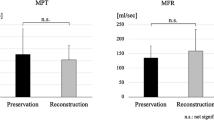Abstract
The objective of this study was to compare time-dependent improvements in phonatory function and stroboscopic findings following two different procedures for immediate reconstruction of the recurrent laryngeal nerve (RLN) during neck tumor extirpation. Seventeen patients with neck tumors, consisting of advanced thyroid cancer (n = 15), metastatic neck lymph nodes from other malignant lesions (n = 2), underwent resection of the primary lesion and involved RLN. Immediate RLN reconstruction by either: (1) ansa cervicalis nerve (ACN) to RLN anastomosis (n = 8); or (2) placement of the great auricular nerve (GAN) between the cut ends of the RLN (n = 9) was performed from 2000 to 2011. Phonatory function [maximum phonation time, mean airflow rate (MFR), jitter, and shimmer) and stroboscopic findings (regularity, amplitude, and glottal gap) were examined at 1, 6, and 12 months postoperatively. Stroboscopic findings were assessed by two otolaryngologists and one speech pathologist. There were no significant differences in any parameter for either phonatory function or stroboscopic findings between ACN and GAN with the exception of jitter and shimmer, in which ACN was superior to GAN at 1 month postoperatively. All parameters improved significantly between 1 and 12 months postoperatively for both phonatory function and stroboscopic findings (P < 0.05). Either method of immediate RLN reconstruction at the time of neck tumor extirpation (i.e., ACN or GAN) provided both excellent long-term postoperative phonatory function and stroboscopic findings, and there was little difference in vocal outcome between the two procedures.



Similar content being viewed by others
References
Orestes MI, Neubauer J, Sofer E, Salinas J, Chhetri DK (2014) Phonatory effects of type I thyroplasty implant shape and depth of medialization in unilateral vocal fold paralysis. Laryngoscope 124(12):2791–2796
Woodson G (2010) Arytenoid abduction: indications and limitations. Ann Otol Rhinol Laryngol. 119(11):742–748
Mikaekian DO, Lowry LD, Sataloff RT (1991) Lipoinjection for unilateral vocal cord paralysis. Laryngoscope 101:465–468
Miyauchi A, Inoue H, Tomoda C, Fukushima M, Kihara M et al (2009) Improvement in phonation after reconstruction of the recurrent laryngeal nerve in patients with thyroid cancer invading the nerve. Surgery 146:1056–1062
Chou FF, Su CY, Jeng SF, Hsu KL (2003) Lu KY Neurorrhaphy of the recurrent laryngeal nerve. J Am Coll Surg 197:52–57
Yumoto E, Sanuki T (2006) Kumai Y Immediate recurrent laryngeal nerve reconstruction and vocal outcome. Laryngoscope 116:1657–1661
Paniello RC (2000) Laryngeal reinnervation with the hypoglossal nerve: II. Clinical evaluation and early patient experience. Laryngoscope 110:739–748
Zheng H, Zhou S, Chen S, Li Z, Cuan Y (1998) An experimental comparison of different kinds of laryngeal muscle reinnervation. Otolaryngol Head Neck Surg 119:540–547
Green DC, Berke GS, Graves MC (1991) A functional evaluation of ansa cervicalis nerve transfer for unilateral vocal cord paralysis: future directions for laryngeal reinnervation. Otolaryngol Head Neck Surg 104:453–466
Zheng H, Li Z, Zhou S, Cuan Y, Wen W, Lan J (1996) Experimental study on reinnervation of vocal cord adductors with the ansa cervicalis. Laryngoscope 106:1516–1521
Kumai Y, Ito T, Matsukawa A, Yumoto E (2005) Effects of denervation on neuromuscular junctions in the thyroarytenoid muscle. Laryngoscope 115:1869–1872
Maronian N, Robinson L, Waugh P et al (2003) Electromyographic findings in recurrent laryngeal nerve reinnervation. Ann Otol Rhinol Laryngol 112:314–322
Dedo HH (1971) Electromyographic and visual evaluation of recurrent laryngeal nerve anastomosis in dogs. Ann Otol Rhinol Laryngol 80:664–668
Haller JR, Shelton C (1997) Medial antebrachial cutaneous nerve: a new donor graft for repair of facial nerve defects at the skull base. Laryngoscope 107:1048–1052
Author information
Authors and Affiliations
Corresponding author
Ethics declarations
Conflict of interest
We have neither financial disclosure nor conflict of interest.
Additional information
Y. Kumai and N. Kodama contributed equally to this paper.
Rights and permissions
About this article
Cite this article
Kumai, Y., Kodama, N., Murakami, D. et al. Comparison of vocal outcome following two different procedures for immediate RLN reconstruction. Eur Arch Otorhinolaryngol 273, 967–972 (2016). https://doi.org/10.1007/s00405-015-3852-x
Received:
Accepted:
Published:
Issue Date:
DOI: https://doi.org/10.1007/s00405-015-3852-x




